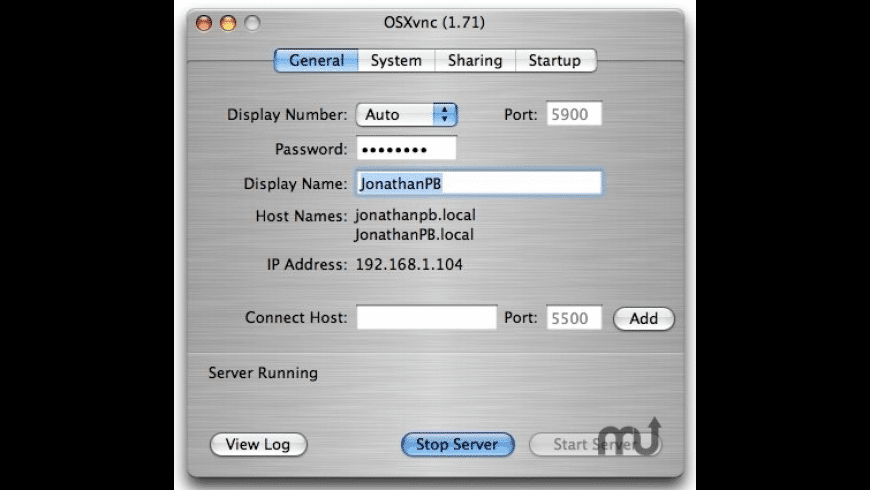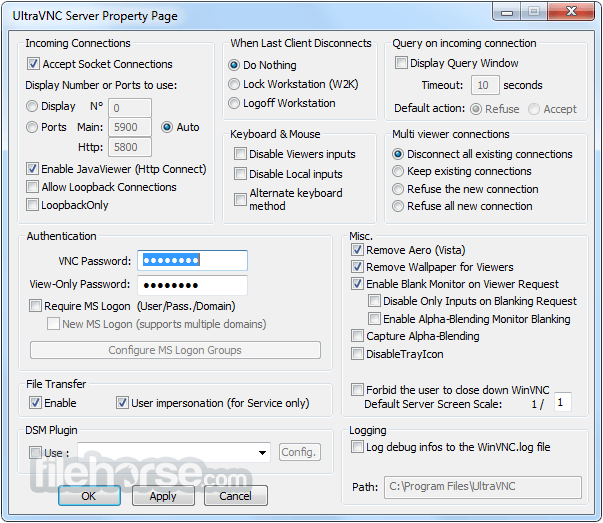Apple includes a VNC server in every edition of Mac OS X 10.4 and later. You can start the server through a discrete check box in the Sharing preferences.
UltraVNC by UltraVNC is an open source piece of software that allows you to remotely control a computer., Free download UltraVNC UltraVNC for Mac OS X. UltraVNC is a powerful, easy to use and free software that can display the screen of another., Alternatives to UltraVNC AnyDesk Remote desktop app for sharing screens and files. Aug 26, 2021 Proctortrack for Mac OS X. Proctortrack 20.2. Request DOWNLOAD link when available. View remote desktops and control. Java Viewer — a cross-platform “run-anywhere” client. TightVNC is interoperable with wide range of VNC-compatible server and client software. For example, TightVNC viewers can connect to standard VNC, TightVNC, UltraVNC, x11vnc, Apple Remote Desktop in Mac OS X, Xen/HVM, VMWare, Qemu etc.
This article refers to Mac OS X 10.4, aka Tiger. More recent versions are available on our VNC on Mac OS X page.
Ultra VNC for Mac. UltraVNC by UltraVNC is an open source piece of software that allows you to remotely control. AnyDesk for Mac. Ultra VNC is a powerful, easy to use and free - remote pc access softwares - that can display the screen of another computer (via internet or network) on your own screen. The program allows you to use your mouse and keyboard to control the other PC remotely. It means that you can work on a remote computer, as if you were sitting in front of it, right from your current location.
A VNC server lets you control your Mac from another computer. The other computer does not need to be a Mac; it can be a Windows PC.
Tightvnc
There are a number of VNC servers available for the Mac. These are no longer needed with Mac OS X 10.4 and later.
The VNC server built into your Mac is free, easy to switch on, and supported by Apple.

Vnc For Windows Xp
Starting the Mac OS X VNC Server
- Launch the System Preferences.
Screenshot 1: Launch System Preferences
- Select the Sharing preferences.
Screenshot 2: Open the Shared preferences.
- Enable Apple Remote Desktop within the Services panel.
Screenshot 3: Enabled Apple Remote Desktop.
- Enable VNC viewers may control screen with password: in the Access Privileges… sheet.
Screenshot 4: Enabled VNC viewers.
- Enter a hard to guess pass phrase. You will need this to connect from the remote computer.
- Click OK to save your settings.

You are now running a VNC server and can connect remotely to your Mac.
To connect you need a VNC viewer. Thankfully these are numerous and many are free.
Ultravnc For Mac Os X
Try the oddly named Chicken of VNC — Wikipedia claims the name is a play on words referencing the Chicken of the Sea Tuna brand.
Why mention this?
Mac Os X Download Iso
The built-in VNC server on Mac OS X appears to be a little known feature. For administrators, and those looking after Macs for distant family members, VNC is fantastic.
If you are looking for an easier, or one off, means of remote access, take a look at Fog Creek's Copilot service.

Ultravnc For Mac
Hope this helps.
Connecting to the built-in Mac VNC server from a Windows machine
A little-known fact about Mac versions 10.4 (Tiger) and over, is that they come with a built-in VNC server. This feature is included in a couple of the “Sharing” options and can be accessed with a regular VNC viewer/client.
However, when connecting from a Windows machine (particularly when running TightVNC as the viewer), I found I had to configure a few extra settings to make it work without constant freezes on my Mac, forcing me to hard reset. Here are some of the tweaks I had to make to ensure I could connect without issues. I am running 10.7.5 (Lion), so your steps may vary slightly.
Firstly, you need to allow VNC connections. The two options are either Screen Sharing or Remote Management. Screen Sharing is what the “average” VNC user may need, while the latter is helpful if you need more permissions and control over the host machine.
Allowing VNC connections:
- Step 1 – Go to your System Preferences and under the Internet and Wireless heading, click on Sharing.
Step 2 – Enable either the Screen Sharing or the Remote Management checkboxes.
Step 3 – Click on Computer Settings and enable “VNC viewers may control screen with password.”
Step 4 – Provide a password and click “OK”.
(Only for Remote Management)
Step 5 – Click on Options and enable any other permissions you may need.
You should now have a VNC server running on the standard port 5900 of your machine. You should (in theory) be able to connect to your Mac with any viewer using your machine’s IP address and the port. As I mentioned before, I had some issues connecting from Windows, and had to take a few precautions. I’m using TightVNC, so these changes may or may not be necessary on other viewers.
Tweaks for Windows:
- To prevent receiving a patterned, gray screen after the login, be sure to logout of your current user on your Mac first. The viewer will prompt for a password, but once connected, will not display the actual desktop unless no users are logged in on the host.
- In the Options menu:
- Enable “Disable clipboard transfer.” This was a major issue that would cause freezing immediately upon on connect unless enabled. Of course, you will not be able to share the clipboard across the host and client machines, but at least the host machine will continue running properly.
- Set the “Preferred Encoding” to either “Raw” or “ZRLE”. The other options appeared to work, but seemed to cause some minor freeze-ups on the Mac.
- Oftentimes after closing the viewer, the Mac would freeze yet again, requiring a reset. One workaround is to click the “Pause” button (double red bar) in the active Viewer before closing the connection. Have not yet gotten a chance to look into why this works, but it seems to solve the problem for the time being.
Following these steps should help ensure you can connect to your Mac from a Windows machine. Just enter <host IP>:5900 as the Remote Host and enter the password from before to connect.
Of course, another option is to simply user a third-party VNC server, but if you don’t feel like installing more software, hopefully this should help in preventing a few headaches.
Igor Shults